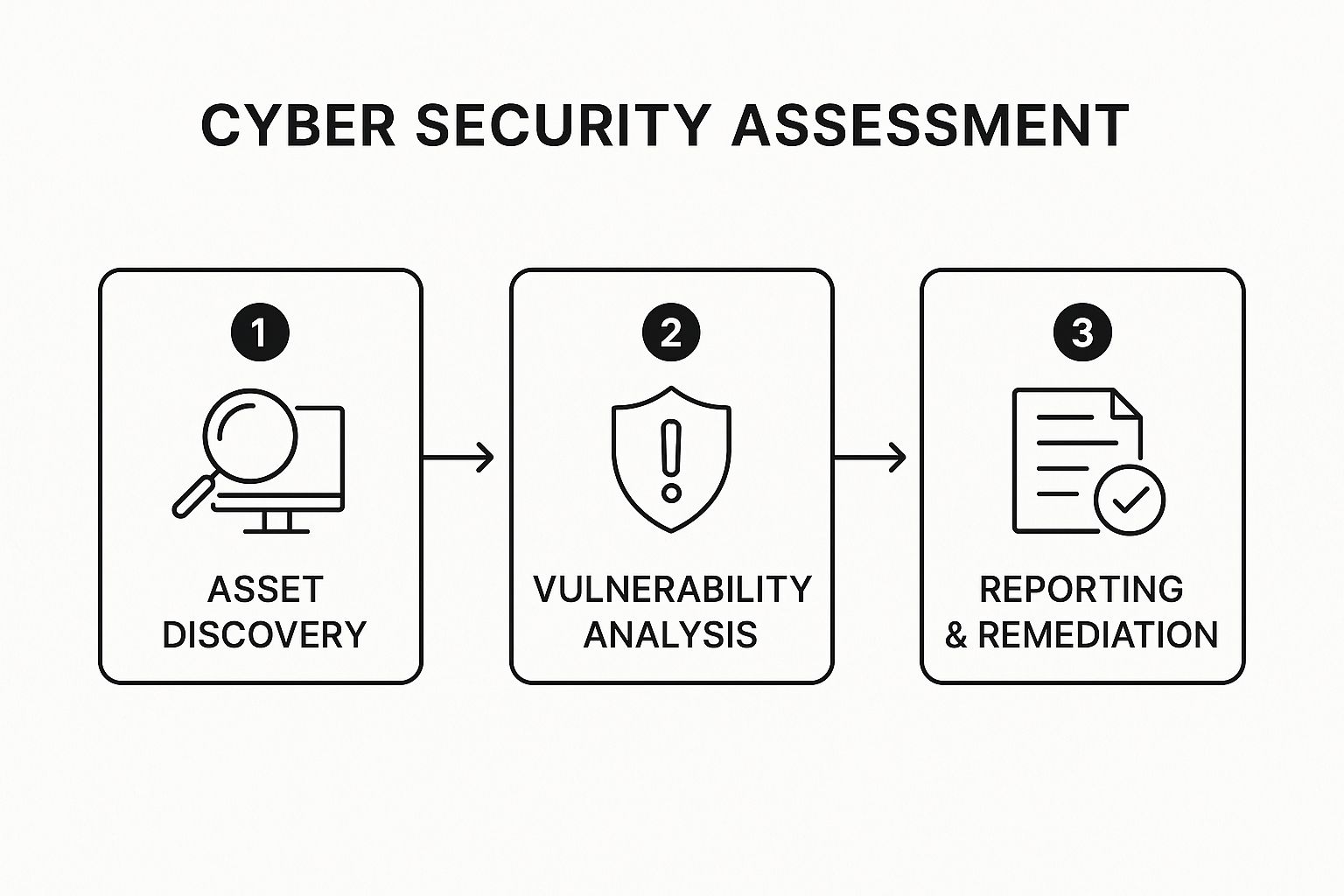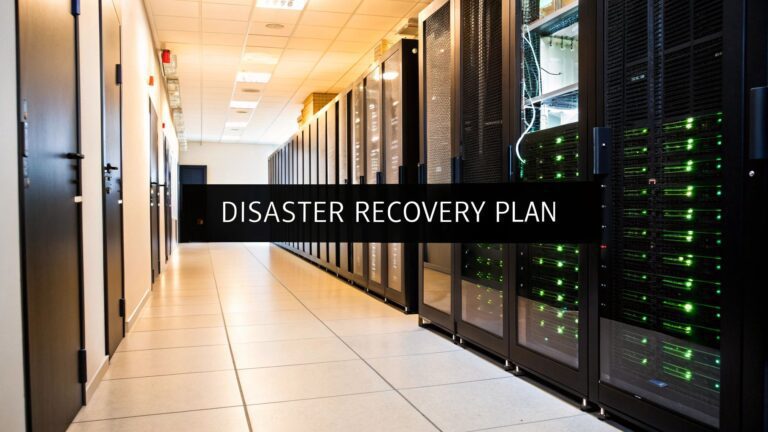A cyber security assessment is your way of getting ahead of the game. Think of it as a top-to-bottom health check for your entire digital world, designed to uncover the weak spots and security gaps before a hacker does. It's about swapping uncertainty for a clear, actionable security plan.
Why Assessments Are Your Best Security Investment

Let's be honest, cyber security can feel like a minefield. The technical jargon alone is enough to make anyone’s head spin, and the list of potential threats seems to grow by the day. It’s no wonder many business owners just hope for the best, assuming a breach is something that happens to other companies.
But hoping isn't a strategy. That reactive mindset is a massive gamble with your business's future. A proactive cyber security assessment isn't just another item on a technical to-do list; it's one of the smartest strategic investments you can make. It fundamentally shifts your position from being defensive and unsure to being informed and in control.
Moving From Guesswork To Strategy
Without a proper assessment, you're essentially throwing money at security problems you don't fully understand. You might buy the latest firewall or the most expensive antivirus software, but are you sure those are the right tools to protect your most critical data?
An assessment cuts through the noise by answering the most important questions:
- What are our most valuable digital assets? Think customer data, financial records, or intellectual property.
- Where does this crucial information live, and who can actually access it?
- What are the most credible threats we face right now?
- How well are our current security measures actually working to stop these threats?
Once you have these answers, you can start aligning your security budget with genuine business risk. This ensures every pound you spend is working as hard as possible to protect what matters, stopping you from wasting money on solutions that don't address your unique vulnerabilities.
A proper assessment transforms your security mindset. It’s no longer about buying products; it’s about managing risk in a way that directly supports your business objectives.
The Stark Reality of Cyber Threats in the UK
This isn't just about theoretical threats. The latest UK government data shows that 38% of businesses and 24% of charities reported a cyber security breach or attack in the last 12 months. For medium and large businesses, the figures are even more alarming, with breach rates of 59% and 69% respectively. The numbers make it clear: for most organisations, it's a matter of "when," not "if."
Think about a small accounting firm I worked with. They were confident their standard IT setup was enough. An assessment, however, quickly flagged that their cloud storage—full of sensitive client tax information—was dangerously misconfigured. That single discovery allowed them to fix a critical vulnerability that could have easily led to a devastating data breach, heavy regulatory fines, and a damaged reputation they might never recover from.
Vulnerabilities like this are common, even in widely-used platforms. You can learn more about Office 365 cyber security in our detailed guide to see how a focused approach can make a difference.
A cyber security assessment gives you a clear, actionable roadmap. It’s the key to understanding threats, prioritising your response, and building a resilient security posture that truly protects your organisation.
Defining the Scope of Your Assessment
Before you even think about running a single scan, you have to set the boundaries. This is where many cyber security assessments go wrong right from the start. Without a clear scope, you'll either try to boil the ocean and assess everything at once—which is a recipe for failure—or you'll miss something critical.
Think of it like this: you wouldn't tell a builder to just "fix the house". You'd point them to the leaky roof in the extension and the faulty wiring in the kitchen. A well-defined scope is your roadmap. It focuses your time, money, and energy where they'll have the biggest impact.
Identifying Your Critical Assets
First things first, what actually matters to your business? You need to pinpoint your most valuable assets—the data, systems, and processes that are absolutely essential for keeping the lights on. These are your crown jewels. If they were to be compromised, the fallout would be severe, from financial loss to a complete breakdown in customer trust.
Let’s take a mid-sized e-commerce company as a real-world example. Their crown jewels would likely be:
- The Customer Database: This holds personal details, addresses, and purchase histories. A breach here isn't just a technical problem; it's a PR nightmare and a one-way ticket to hefty GDPR fines.
- The Payment Processing Gateway: This is the heart of the operation. If it stops, so does your revenue. It's as simple as that.
- The Product Inventory System: This might seem less obvious, but if it's inaccurate, you can't fulfil orders. That leads directly to unhappy customers and operational chaos.
On the other hand, the internal marketing blog, while useful, isn't on the same level of criticality. By separating the high-value assets from the nice-to-haves, you can focus your assessment efforts with surgical precision. It's about protecting what truly powers your business.
Mapping Your Attack Surface
Once you know what you're protecting, you need to figure out where it is and how an attacker might get to it. This means mapping your entire digital footprint, what we call the attack surface. It’s every single piece of hardware, software, and cloud service that could serve as an entry point for a threat.
This inventory process involves documenting everything:
- Network Infrastructure: Every server, workstation, router, switch, and firewall in your environment.
- Software and Applications: All your off-the-shelf software packages and, crucially, any custom-built applications.
- Cloud Services: Any platforms your business relies on, like Microsoft 365 or AWS.
- Data Storage: Where is your critical data actually stored? Is it on-site, in the cloud, or with a third-party provider?
Getting all of this down on paper gives you a bird's-eye view of your environment. You’ll start to see how systems are connected and where the weak points might be hiding.
Scoping isn’t just about making a list of technology. It’s about understanding the business context behind each asset and focusing your security efforts on what would cause the most harm if compromised.
Understanding Compliance and Regulatory Needs
Your scope must also account for any legal or regulatory hoops you need to jump through. For almost every UK business, this means complying with the General Data Protection Regulation (GDPR) when handling personal data. If you’re in a sector like finance or healthcare, you'll have even stricter rules to follow.
These regulations aren't just suggestions; they often dictate specific security controls and how often you need to be assessed. Ignoring them can lead to serious penalties, so compliance has to be a core part of your scope. The core principles of identifying and evaluating threats are universal, and you can see similar logic in other fields—for instance, in various fleet risk assessment strategies.
Many organisations find it helpful to align their assessments with an established security framework like ISO/IEC 27001, which offers a proven, structured approach to managing information security.
Here’s a look at the clauses within the ISO/IEC 27001 standard, which provides a fantastic structure for security efforts.
This structure shows how a framework helps you move logically from understanding the organisation's context all the way through to performance evaluation and improvement. It’s a complete model for managing information security systematically.
Getting the Right People Involved
Finally, and this is crucial, a cyber security assessment is not just a job for the IT department. It’s a business-wide initiative. To define a scope that actually means something, you need input from across the company. Pull together a team with people from IT, legal, operations, and, most importantly, senior management.
This collaboration is what makes the assessment truly effective. Management can tell you which processes bring in the most revenue. The legal team can guide you on compliance. This holistic approach ensures your final scope is not only technically sound but also perfectly aligned with your organisation's strategic goals.
Practical Ways to Uncover Vulnerabilities

With a clear scope defined, it’s time to get into the really interesting part of any cyber security assessment: the hunt for weaknesses. This is where we shift from planning to actively probing your defences to see where the cracks are. The aim is simple – find the vulnerabilities before an attacker does. That head start is invaluable.
To do this right, you need a blend of automated precision and human creativity. It’s not a case of one being better than the other; they are two sides of the same coin. Each plays a specific, vital role in uncovering different types of risk.
The Power of Automated Vulnerability Scanning
Automated scanning is your first line of offence in the discovery phase. I like to think of tools like Nessus or OpenVAS as tireless digital inspectors. They methodically check every system, application, and device within your scope against a massive, constantly updated database of known vulnerabilities.
These scanners are incredibly fast and efficient. They’re brilliant at identifying the common, often-overlooked security flaws that can leave you exposed. Things like:
- Outdated Software: Running unpatched versions of operating systems or applications is one of the most common ways attackers get in. It's a classic.
- Default Configurations: Leaving default passwords or settings on hardware and software is like leaving your front door not just unlocked, but wide open.
- Known Exploits: Scanners check for thousands of well-documented vulnerabilities that have ready-made exploits circulating among criminals.
Let’s go back to our e-commerce company example. An automated scan would almost instantly flag that their web server is running an old version of its software, leaving it exposed to a known remote code execution flaw. Finding something like this is a quick, high-impact win that immediately slashes your risk profile.
Automated scanning gives you breadth. It covers your entire defined attack surface quickly and efficiently, making it the perfect way to catch low-hanging fruit and establish a solid security baseline.
The Necessity of Manual Penetration Testing
While scanners are great at finding the known issues, they can't spot everything. They just don't have the context or the creativity of a human attacker. This is precisely where manual penetration testing, or "pen testing," comes into its own. A pen tester doesn’t just look for known flaws; they actively try to exploit them and think outside the box to find weaknesses in your logic and processes.
A good pen tester can uncover complex issues that an automated tool would sail right past. I'm talking about things like:
- Business Logic Flaws: Abusing a system's intended function in a completely unintended way. For instance, a pen tester might discover they can add a £1,000 item to their basket and then manipulate the request to change the price to £1 before checkout.
- Chained Exploits: This is where the real skill comes in. It involves combining several seemingly low-risk vulnerabilities to create one critical-risk entry point.
- Human Vulnerabilities: Testing how susceptible your team is to manipulation through social engineering attacks like phishing.
The UK's cyber security landscape shows just how important this is. With 20% of businesses reporting at least one cybercrime in the last year, the threat is persistent. While risks vary by sector, phishing is overwhelmingly the most common attack vector, which really underscores the need to test your human defences.
That human element is absolutely crucial. To get a better handle on defending against these tactics, our detailed guide offers practical advice on https://www.ibertechsolutions.co.uk/protecting-against-phishing-email-scams.
Blending Internal and External Perspectives
A thorough assessment always looks at your organisation from two angles: from the outside in (an external assessment) and from the inside out (an internal assessment). An external test simulates what a random hacker on the internet could see and do. An internal test, however, simulates a far more dangerous scenario: what a malicious employee or an attacker who has already breached the perimeter could achieve.
This dual perspective is vital. You might have a rock-solid firewall that stops external threats cold, but a weak internal network could allow one compromised employee laptop to infect your entire system.
To get ahead of these issues, many organisations are now weaving security into the development pipeline itself by integrating DevSecOps best practices. This approach helps build security into your applications from the very beginning, rather than trying to bolt it on at the end.
By combining automated scans with manual testing and looking at both internal and external threats, you start to build a genuinely comprehensive picture of your security posture. This multi-faceted approach ensures you uncover not just the obvious technical flaws, but also the subtle, complex vulnerabilities that often pose the greatest risk to your business.
From Findings to a Prioritised Action Plan
https://www.youtube.com/embed/YKzZvYD7bYc
So, you've run your scans and now you're staring at a long list of vulnerabilities. This is a common point where people get stuck. A raw report from a scanning tool is often just a wall of technical jargon – overwhelming and, frankly, not very useful on its own. The real value comes from turning that data into a clear, prioritised action plan.
This is where risk analysis becomes your best friend. It’s all about adding business context to those technical flaws. You’re not just fixing bugs; you're building a strategic roadmap for remediation. The truth is, not all vulnerabilities are created equal, and you can't fix everything at once. Prioritisation is everything.
Understanding Risk Likelihood and Impact
To get started, you need to weigh up each vulnerability against two simple but incredibly powerful metrics: impact and likelihood.
- Impact: If this vulnerability were exploited, how bad would the damage actually be? Don't just think technically. Think about the real-world business consequences—are we talking about financial loss, reputational damage, operational downtime, or even regulatory fines?
- Likelihood: How probable is it that an attacker will actually find and use this vulnerability? This isn't a wild guess. It's based on factors like how easy the flaw is to exploit and whether the system in question is exposed to the internet.
Let's be practical. A critical-severity flaw on your public-facing e-commerce server that handles payments? That's a five-alarm fire. The impact is catastrophic, and the likelihood is high. On the other hand, a low-impact bug on an isolated internal development machine holding no sensitive data can probably wait. This simple evaluation helps you focus your limited time and resources where they’ll make the biggest difference.
This process, from discovery to reporting, is a logical flow. You can't create a meaningful action plan without first understanding what you have and where the weaknesses are.

As you can see, discovering your assets and analysing their vulnerabilities are the essential groundwork. Without them, your reporting and remediation efforts are just guesswork.
Creating a Simple Risk Matrix
One of the most effective tools I've used to visualise priorities is a simple risk matrix. This grid helps you plot each vulnerability based on its impact and likelihood, giving you an instant, at-a-glance view of your risk landscape. By assigning a score, you can categorise issues and create a clear hierarchy for your action plan.
To help you prioritise, a risk matrix is an excellent visual tool. It maps vulnerabilities based on their potential impact against the likelihood of being exploited, immediately showing you what needs urgent attention.
Sample Risk Prioritisation Matrix
| Impact Level | Low Likelihood | Medium Likelihood | High Likelihood |
|---|---|---|---|
| High | Medium Priority | Critical Priority | Critical Priority |
| Medium | Low Priority | Medium Priority | High Priority |
| Low | Low Priority | Low Priority | Medium Priority |
Looking at this matrix, it's clear that any vulnerability falling into a "Critical Priority" box needs your immediate attention. These are the risks that pose a genuine, clear, and present danger to your business. Items in the "Medium Priority" boxes should be tackled next, while "Low Priority" issues can be monitored or fixed when you have the resources.
The goal of a risk matrix isn’t academic precision; it’s about creating a clear, defensible rationale for where you direct your remediation efforts first. It turns a subjective debate into a data-informed decision.
This structured approach is what makes a proper cybersecurity assessment so valuable—it provides the clarity you need to make smart security decisions. For many small and medium-sized businesses, managing this process in-house can be a huge drain on resources.
This is often where getting expert help makes a world of difference. If your team is already stretched thin, considering outsourced IT support can provide the specialist expertise needed to manage remediation effectively, ensuring those critical risks are handled promptly and correctly. By translating technical findings into tangible business risks, you build a powerful case for action that leadership can understand and get behind.
Creating Reports and a Remediation Roadmap

Conducting a thorough cyber assessment is a solid achievement, but frankly, it’s only half the job. The real value comes from turning those findings into action. A detailed report that ends up sitting on a digital shelf is a complete waste of effort. To make a genuine difference, you have to build a narrative that actually drives change, and that means knowing your audience.
In my experience, you’re essentially writing two entirely different reports from the same data set. One needs to speak the language of risk and strategy for your leadership team, while the other must provide the granular detail your technical folks need to start fixing things.
Reporting for the Boardroom
Your executive team doesn't need—or want—to get bogged down in the minutiae of specific software versions or obscure vulnerability codes. They operate on a different level. They need to understand one thing above all else: business risk. Your executive summary has to be sharp, clear, and focused squarely on the bottom line.
It's your job to translate the technical jargon into tangible business threats. For instance:
- Instead of: "The main web server is running an outdated version of Apache."
- Try: "A critical flaw in our website software could let an attacker take our online shop offline. Based on current sales, that could cost us thousands in lost revenue for every hour it's down."
Frame everything around potential financial losses, reputational damage, and legal or regulatory penalties. I've found that using visuals like simple charts and graphs to show the risk landscape at a glance is incredibly effective. This approach shifts the conversation from a technical problem into a strategic business imperative that demands their attention and, crucially, their investment.
Reporting for the Technical Team
On the flip side, your IT and security teams need the exact opposite. Their report has to be a detailed, technical document that leaves no room for ambiguity. This document is their blueprint for plugging the gaps you’ve found.
This technical deep-dive should include:
- Specific Vulnerabilities: Pinpoint each finding with its exact location, whether it’s a server, application, or network device.
- Severity Ratings: Use the risk matrix you developed earlier to clearly prioritise every single issue.
- Replication Steps: Detail exactly how you found the vulnerability so the team can verify it themselves.
- Recommended Fixes: Give them clear, actionable guidance on how to remediate the problem, whether that's applying a patch, changing a configuration, or updating a policy.
The goal here is to empower your team to start working immediately, without them needing to circle back with a dozen questions.
An effective report isn’t about showing off how many flaws you found. It’s about creating a compelling case for action for leadership and providing a clear, actionable guide for the people on the ground who will implement the changes.
Building Your Remediation Roadmap
With your reports drafted, the final piece of the puzzle is to create a time-bound remediation roadmap. This is what elevates your assessment from a one-off project into an ongoing cycle of improvement. A good roadmap isn't just a to-do list; it’s a strategic plan with clear accountability.
Your roadmap absolutely must assign clear ownership for every single remediation task. Put a name or a team against each fix. From experience, if a task has no owner, it will inevitably fall through the cracks. It's also vital to set realistic deadlines. Sit down with the task owners and agree on timelines that are achievable for both quick fixes and longer-term projects.
This kind of ongoing vigilance is non-negotiable. The threat certainly isn't going away. Recent government statistics show that 20% of UK businesses and 14% of charities reported cyber incidents. You can read the full details in the official Cyber Security Breaches Survey. This really highlights the persistent challenge organisations face.
A structured plan, with defined owners and deadlines, is your path to turning assessment data into measurable security improvements and building genuine cyber resilience.
Your Cyber Security Assessment Questions Answered
It's completely normal to have a lot of questions when you're wading into the world of cyber security assessments. Getting clear, straightforward answers is the first step towards building a more robust defence, so let’s tackle some of the most common queries we hear from organisations just like yours.
The aim here isn't to give you generic advice, but to provide the kind of practical insights that help you move forward with genuine confidence. From getting the timing right to understanding the real difference between security tests, this is about equipping you to make choices that truly fit your business needs and budget.
How Often Should My Organisation Run an Assessment?
There's no single, magic number here, but a solid rule of thumb is to conduct a full, comprehensive assessment at least once a year. Think of it as an annual MOT for your entire digital estate. This regular rhythm ensures you’re keeping up with new threats and the constant changes within your own systems.
However, your annual schedule isn't the only trigger. Certain events should always prompt an immediate assessment, no matter when your last one was.
- Significant System Changes: Rolling out new enterprise software, overhauling your network architecture, or launching a major customer-facing application.
- A Move to the Cloud: Shifting critical operations or sensitive data to a new cloud service provider is a big deal for security.
- After an Incident: If you've suffered a breach, an assessment isn't just a good idea—it's essential for understanding how it happened and making sure it doesn't happen again.
For businesses in high-stakes sectors like finance, legal services, or healthcare, a more frequent check-in is wise. We often find that quarterly vulnerability scans, topped off with an annual deep-dive penetration test, provide the right level of assurance.
What’s the Real Difference Between a Vulnerability Assessment and a Penetration Test?
This is easily one of the most common points of confusion, and getting it right is vital for budgeting and setting expectations. They are two very different tools for two very different jobs.
A vulnerability assessment is a broad, automated scan. It uses specialised tools to sweep across your systems, comparing what it finds against a massive database of known flaws. It’s a bit like checking every door and window in your office to see if any are unlocked. Its strength is providing breadth and a comprehensive inventory of potential weaknesses.
A penetration test (pen test) is something else entirely. It's a focused, manual, and goal-driven simulation. A human expert—an ethical hacker—actively tries to get past your security controls and exploit the vulnerabilities found. This is more like hiring a security professional to physically try to break into your building and see how far they can get. It provides depth and real-world context.
A vulnerability scan tells you where the holes might be. A penetration test shows you what an attacker could actually do with them. A mature security strategy needs both.
Should We Do This In-House or Hire External Experts?
Trying to handle an assessment internally can look like a great way to save money. After all, your team knows your systems inside and out. But that familiarity can create a massive blind spot: you lose an independent, objective perspective.
Your team might have unintentional biases or be so used to the environment that they overlook configurations an external expert would spot in a heartbeat. Outside assessors bring a fresh pair of eyes, specialised tools, and up-to-the-minute knowledge of the latest attack techniques.
What we see working best for many organisations is a hybrid approach:
- The Internal Team: Handles regular, frequent vulnerability scanning (say, monthly or quarterly) to maintain a good level of day-to-day security hygiene.
- External Experts: Are brought in annually for the heavy lifting—an in-depth penetration test and a comprehensive security review.
This gives you the best of both worlds. You get consistent internal monitoring, backed up by the rigorous, impartial validation that only a third party can deliver. Plus, for many compliance standards, an independent audit is a requirement, making external help a necessity.
What's a Reasonable Budget for a Cyber Security Assessment?
The honest answer is: it varies—a lot. The final cost depends on a few key factors: the size and complexity of the systems you need testing (the scope), the depth of that testing (a quick scan versus a full-blown pen test), and the experience of the firm you hire.
For a small business, a basic automated vulnerability scan might cost a few thousand pounds. For a larger, more complex organisation with custom-built applications, a manual penetration test could easily run into the tens of thousands.
The most important thing is to change how you think about the expense. Don't see it as a cost; see it as an investment in your company's resilience. The potential fallout from a data breach—when you factor in regulatory fines, recovery costs, legal fees, and reputational damage—almost always dwarfs the price of being proactive. When you're looking at proposals, get quotes from several reputable firms and make sure you’re comparing like-for-like services.
Navigating the complexities of a cyber security assessment can feel daunting, but you don't have to go it alone. The expert team at Ibertech Solutions Limited provides professional IT support and security services to help you identify vulnerabilities and build a robust defence. Get in touch today to see how we can secure your business.





